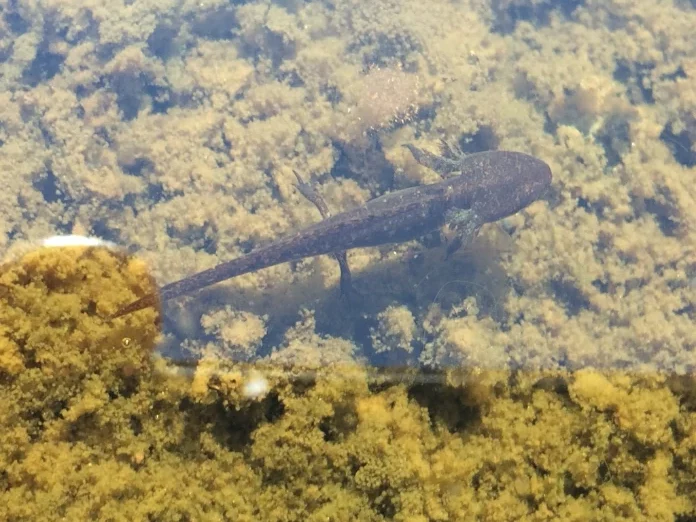If you’ve ever crouched by a pond in spring and watched the water come alive with tiny, wiggling shapes, you might have wondered: are those tadpoles, or are they something else? And if they’re newts, do they actually change like frogs do?
Yes, newts go through metamorphosis, but their transformation is very different from frogs. Instead of losing their tails and hopping onto land like frogs, newts grow in stages, each one helping them live both in water and on land.
What Metamorphosis Really Means for Amphibians
Metamorphosis is just a fancy way of saying “changing form.” For amphibians, it means they start life in water with gills and slowly turn into adults that can live on land.
Frogs do this in a dramatic way: they start as swimming tadpoles, then grow legs, lose their tails, and turn into leaping adults.
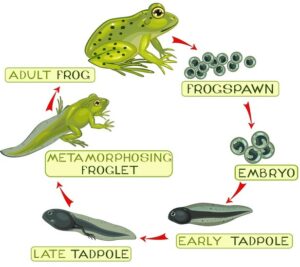
Newts also change, but they keep their tails, and they have an extra stage most people don’t know about.
How Do Newts Start Their Lives in the Water?
Every spring, female newts lay their eggs in ponds. Instead of big clumps of jelly like frogs, newts lay single eggs and often wrap them in leaves.
Each egg looks hidden, almost like a tiny secret tucked away.
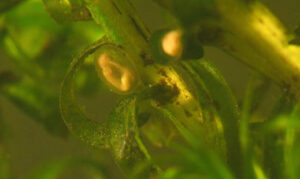
From these eggs hatch the larvae, small, slim, fish-like babies with frilly gills sticking out from the sides of their heads. They use these gills to breathe, just like tadpoles.
At this stage, it’s easy to mistake them for baby fish or young frogs, until you notice those little gills waving in the water.
What Happens During the Larval Stage?
As larvae, newts live completely underwater. They swim with their tails, eat tiny insect, and grow steadily. This is the first stage of their change.
Newt larvae already look like tiny versions of adults, long bodies, flat tails, and four little legs forming.
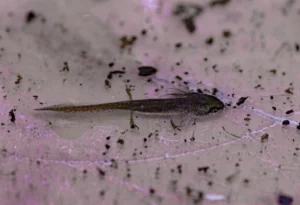
Frogs, by contrast, start with no legs at all and grow them later.
Newts follow a slower but more direct path in their change.
When Do Newts Start Changing?
After a few weeks, the larvae start getting ready for life outside water. Their gills shrink, lungs grow, and their skin gets a bit rougher and tougher.
They’re no longer just water creatures. Their bodies are getting ready to survive on land. This is the heart of metamorphosis, the moment when they leave one world for another.
The Stage Most People Don’t Know: The Eft
Here’s where newts really stand out. After leaving the water, many species (like the eastern newt) enter a stage called the eft. These little juveniles live entirely on land for several years.
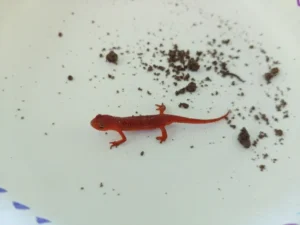
If you walk in the woods after rain, you may see them crawling slowly over leaves or logs. Their bright color warns predators, they taste bitter and unpleasant.
This land stage doesn’t happen in frogs. It’s a special twist in the newt’s life cycle and makes their change more complex.
Why Do Newts Spend Time on Land Before Going Back to Water?
You might wonder, why don’t they just stay in the pond and grow up there? The answer is balance.
By moving to land for a while, young newts avoid competing with adults for food in the pond.
They can hunt small insects and worms on land while the adults stay in water. This separation makes sure everyone has enough to eat.
It’s like nature giving them space to grow without bumping into each other too much.
How Adult Newts Complete the Journey
After a few years as efts, newts go back to the water as adults. Their skin turns smooth and moist again, perfect for life in the pond.
Their colors may darken, and their tails grow stronger for swimming.

Now they’re ready to breed, repeating the cycle. The adult stage is the final form of their change, though they still switch between land and water depending on the season.
Is Newt Metamorphosis the Same for Every Newt?
Not exactly. Different species do it a little differently:
-
Eastern newts go through the famous red eft stage.
-
Smooth newts in Europe skip the bright land phase and become more dull-colored juveniles before adulthood.
-
Great crested newts grow bigger, but still follow the same path, larva to juvenile to adult.
No matter the species, the pattern is the same: newts change, but they keep their tails and their quiet, water-loving nature.
How Does Metamorphosis Keep Newts Safe?
Changing form isn’t just about growing up, it’s about staying safe.
As larvae in water, their frilly gills let them breathe and hide among pond plants.
As efts on land, their bright colors warn predators.
As adults, their strong tails and slim bodies help them slip through ponds and breed safely.
Each stage is like a new survival suit, made for that part of their journey. Without it, they wouldn’t make it.
Can Newts Get Stuck During Metamorphosis?
Sometimes things don’t go smoothly. In poor conditions (like dirty water, not enough food, or sudden drought) newts may struggle to finish changing.
Some may keep their gills longer than usual, while others may not fully grow strong lungs before leaving water.
In rare cases, some salamanders stay in a larva-like state their whole lives.

This is called neoteny. While it’s more common in axolotls, some newts can do it too if they need to.
What Happens in Winter? Does Metamorphosis Stop?
If newts are in the middle of changing and winter comes, cold slows everything down. Their growth pauses, and they hide under mud or leaves until spring returns.
This stop-and-go pattern shows how flexible they are. Metamorphosis isn’t a race, it adjusts to the rhythm of the seasons.
Why Metamorphosis Matters for the Whole Environment
Newts aren’t just changing for themselves, they’re part of a bigger story. Their different roles help keep balance in their environment.
- As larvae, they eat mosquito larvae, helping control insects.
- As efts, they eat insects and worms in the forest, recycling nutrients.
- As adults, they hunt and get hunted in ponds, linking land and water habitats.
Their metamorphosis puts them into many parts of the food web, making them very important for healthy habitats.
Conclusion
So, do newts change as they grow? Yes, but in their own unique way. From tiny gilled larvae in ponds, to bright red efts wandering on land, to sleek-tailed adults going back to the water, each stage is a carefully made step in their survival.
Unlike frogs, they never lose their tails, and they pass through an extra land stage before adulthood. This makes their change one of the most interesting in the amphibian world.
Next time you see a newt, remember: it didn’t just grow bigger, it lived through a journey of forms, each one made to fit its place in the world.
Hi, my name is Ezra Mushala, i have been interested animals all my life. I am the main author and editor here at snakeinformer.com.

